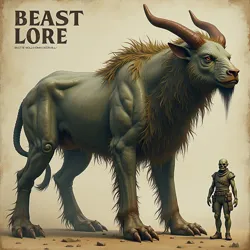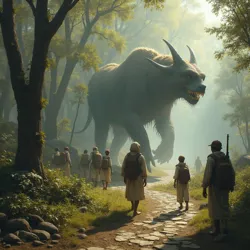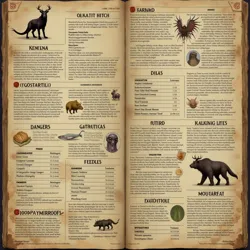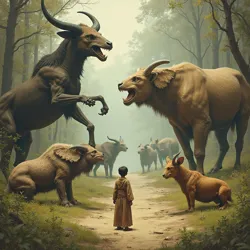Beast Lore

Cumulative knowledge of altered animal life forms known as Xenofauna following a global environmental disruption, essential for human survival.
Beast Lore
Knowledge of altered animal life
The Catalysm
Post-Catalysm Xenofauna
Identification, behavior, dangers, resources
Oral tradition, written records
Essential for human survival
Dynamic and evolving
Beast Lore represents the cumulative body of knowledge, practical wisdom, and cultural narratives developed by human survivors regarding the myriad altered animal life forms known collectively as [Post-Catalysm Xenofauna]. Following the global environmental disruption referred to as The Catalysm, the biosphere was saturated with [Pervasive mutagenic agents] and subjected to [Cascading environmental collapse], resulting in profound and often unpredictable biological changes across the animal kingdom. The resulting Xenofauna, exhibiting novel physiologies, altered sizes, and entirely new biological functions as detailed in the primary article on Post-Catalysm Xenofauna, posed immediate and ongoing threats, challenges, and occasional opportunities for human communities. Beast lore emerged as an essential survival mechanism, a dynamic and evolving repository of information critical for navigation, defense, hunting, and coexistence in the dramatically transformed world.
This body of knowledge encompasses a wide range of information, from basic identification and tracking techniques to detailed understanding of specific creature behaviors, vulnerabilities, and potential uses. Passed down through generations via oral tradition, apprenticeship, and later through codified records and studies, beast lore integrates empirical observation with cultural interpretation, myth, and lived experience. It is not merely a scientific classification or a simple list of dangerous animals; it is a complex cultural artifact reflecting humanity's struggle to comprehend and survive within an ecosystem fundamentally reshaped by catastrophe. The necessity of accurate and comprehensive beast lore underscores the pervasive impact of Post-Catalysm Xenofauna on human societies, influencing settlement patterns, social structures, belief systems, and daily life.
Origins and Development
The origins of beast lore are inextricably linked to the immediate aftermath of the Catalysm and the subsequent emergence of Xenofauna. As familiar animal species began to exhibit bizarre and dangerous alterations, surviving human populations faced an urgent need to identify, understand, and react to these new biological realities. Early lore was born from direct, often brutal, encounters with mutated creatures. Survivors learned through trial and error, observing which altered animals were dangerous, which were harmless, and which might provide sustenance or materials. This foundational knowledge was fragmented, localized, and highly practical, focused solely on immediate survival.
 The pervasive influence of creature knowledge on survival strategies, cultural identity, social structures, and daily life in the altered world.
The pervasive influence of creature knowledge on survival strategies, cultural identity, social structures, and daily life in the altered world.The process of developing structured beast lore was gradual and varied depending on regional environmental conditions and the types of Xenofauna prevalent in different areas. In regions where [Radiation Exposure] was the primary mutagenic force, early lore might focus on identifying creatures with obvious physical deformities or unusual behaviors linked to radiation sickness. In areas dominated by [Chemical Mutagenesis], lore might emphasize identifying animals that thrived in polluted zones and understanding the risks associated with consuming them due to bioaccumulation. The shared experience of confronting the unpredictable nature of Xenofauna formed the basis for the first attempts to systematize this vital knowledge.
Oral Tradition and Early Records
In the absence of widespread literacy or established scientific institutions in the immediate post-Catalysm period, beast lore was primarily transmitted through oral tradition. Elders, experienced hunters, and those who had survived close encounters became the keepers of this knowledge, passing it down to younger generations through stories, cautionary tales, and direct instruction during hunting or foraging expeditions. This period saw the development of regional terminologies for common Xenofauna types and the accumulation of anecdotal evidence regarding their habits and dangers.
Early attempts at recording beast lore often took the form of simple pictographs, carvings, or symbols used to represent dangerous creatures or mark areas where they were commonly found. These early records were highly localized and served primarily as mnemonic aids for oral transmission. The reliability of this early lore varied greatly, often blending accurate observation with superstition and fear. However, it formed the essential foundation upon which more detailed and systematic knowledge would later be built. The emphasis was always on practical application – how to avoid being killed, how to find food, how to utilize resources.
Regional Variations
The diverse environmental impacts of the Catalysm led to significant regional variations in both the types of Xenofauna that emerged and the specific challenges they posed to human populations. Consequently, beast lore developed along distinct regional lines, tailored to the unique ecological landscapes and dominant Xenofauna found in different areas. Communities living near heavily polluted waterways would develop extensive lore concerning the [Murk-Dwellers] and other aquatic mutations, detailing their preferred habitats, feeding cycles, and the specific toxins they might carry. Conversely, communities in mountainous regions might focus their lore on creatures like the [Crag-Striding Ursids], documenting their migration routes, den locations, and immense physical strength.
These regional variations reflect the localized nature of survival and the adaptive strategies employed by different human groups. Lore from one region might be entirely irrelevant or even dangerously misleading in another. This fragmentation of knowledge was a significant challenge in the early post-Catalysm world, hindering communication and cooperation between distant settlements. Efforts to compile and compare regional lore would become a later development, essential for building a more comprehensive understanding of global Xenofauna populations.
The Impact of Written Records
As human societies began to stabilize and literacy rates slowly increased, the systematic recording of beast lore became possible. This marked a crucial transition from purely oral tradition to the creation of written bestiaries, field guides, and analytical studies. Organizations like the [Order of the Beast Wardens] played a significant role in this process, dispatching trained individuals to collect information from various communities, verify observations, and compile standardized records. This shift allowed for the preservation of knowledge across generations with greater accuracy and the wider dissemination of information beyond individual communities.
Written records facilitated the comparison of lore from different regions, revealing common patterns in mutation and behavior across seemingly disparate Xenofauna types. They also allowed for more detailed anatomical illustrations and descriptions, supplementing the often simplified depictions found in early oral lore. While written lore could sometimes lack the nuanced contextual understanding embedded in oral tradition, its ability to be easily copied, shared, and updated provided a powerful tool for human survival and adaptation on a larger scale. The development of formalized training based on these written records ensured that critical knowledge was not lost with the passing of individuals.
Content and Structure of Beast Lore
Beast lore is fundamentally structured around the practical needs of human survival in a world populated by unpredictable and often dangerous creatures. Its content is highly detailed and multifaceted, reflecting generations of accumulated observation and experience. While the specific focus of lore varies depending on the region and the prevalent Xenofauna, certain categories of information are universally critical and form the backbone of any comprehensive beast lore system.
 Detailed information on creature identification, behavior, ecology, dangers, weaknesses, and potential uses as resources.
Detailed information on creature identification, behavior, ecology, dangers, weaknesses, and potential uses as resources.The information contained within beast lore is often hierarchical, starting with broad classifications and progressing to fine-grained details about specific individuals or localized populations. This structure allows users to quickly identify general threats or opportunities before delving into the specifics required for safe interaction. The integration of multiple types of information – visual identification, behavioral patterns, environmental indicators, and historical accounts – is characteristic of effective beast lore.
Identification and Morphology
A core component of beast lore is the accurate identification of Xenofauna. Given the vast array of altered forms resulting from post-Catalysm mutations, this is often a complex task. Lore provides detailed descriptions of physical characteristics, including size, shape, coloration, number and configuration of limbs, presence of novel organs, and any visible signs of mutation or deformity. This includes information on [Size Aberrations], helping individuals recognize whether a creature is an unusually large or small variant of a known type.
Identifying features that distinguish dangerous creatures from relatively harmless ones is paramount. Lore might describe specific markings, vocalizations, or postures that indicate aggression. It also covers the recognition of different stages of development or health in Xenofauna, as these can significantly impact behavior and danger levels. Detailed anatomical knowledge, while often simplified in traditional lore, is essential for understanding potential vulnerabilities or resource yields. Lore keepers develop an eye for subtle cues, such as the specific shimmer of a creature with enhanced [Sensory Augmentations] or the distinct smell associated with one possessing novel metabolic processes.
Behavior and Ecology
Understanding how Xenofauna behave and interact with their environment is critical for survival. Beast lore meticulously documents creature habits, including their activity cycles (diurnal, nocturnal, crepuscular), territorial ranges, social structures (solitary, pack, swarm), and migratory patterns. Information on feeding habits is vital, identifying prey species, hunting methods, and signs of recent kills. This knowledge informs strategies for avoiding dangerous predators or locating potential food sources.
Lore also covers the ecological role of different Xenofauna types, their preferred habitats, and their interactions with other species, including other Xenofauna, surviving pre-Catalysm life, and human settlements. Understanding where a creature is likely to be found, the environmental conditions it favors, and how it responds to changes in its surroundings allows for safer navigation and resource management. For example, lore about the [Glow-Worms of the Contaminated Flats] would detail not only their bioluminescence but also the specific soil conditions they inhabit and the types of decaying matter they consume, indicating areas of high chemical contamination.
Dangers and Weaknesses
Perhaps the most critical aspect of beast lore is the detailed cataloging of dangers posed by Xenofauna and, conversely, their weaknesses. This includes descriptions of attack methods (claws, teeth, toxins, bioelectricity), the effects of their attacks, and methods for treating injuries or exposures. Identifying signs of a creature's presence, such as tracks, scat, nests, or territorial markings, is a key part of preventative lore, allowing humans to avoid dangerous encounters altogether.
Information on weaknesses is equally vital for defense and hunting. This might involve knowledge of specific sensory vulnerabilities (e.g., sensitivity to certain frequencies of sound), physiological weak points, or environmental conditions that hinder the creature (e.g., aversion to light, vulnerability to specific chemicals). Lore often describes effective weapons, tactics, and defensive measures against different Xenofauna types, informing the design of fortifications, tools, and strategies for engaging or deterring threats. The development of specialized techniques for dealing with creatures possessing novel organ systems or extreme resilience is a continuous process within this aspect of lore.
Resources and Utilization
Beyond threats, beast lore also identifies Xenofauna that can serve as resources. This includes creatures whose bodies provide edible meat, useful materials (hides, bones, sinew), or biological compounds with medicinal, toxic, or industrial applications. Lore details how to safely hunt, kill, and process these creatures, recognizing that toxins or diseases present in the live animal might pose risks during consumption or handling.
Knowledge of resource Xenofauna includes identifying their location, peak seasons for hunting or harvesting, and sustainable practices to avoid depleting local populations. Lore keepers understand which parts of a creature are useful, how to prepare them, and any specific precautions needed (e.g., requiring extensive cooking or detoxification processes). This practical knowledge is essential for supplementing scarce resources in the post-Catalysm world and highlights that Xenofauna are not solely viewed as threats but also as integral, albeit dangerous, parts of the new ecosystem.
Transmission and Preservation
The continued existence and effectiveness of beast lore rely heavily on robust systems of transmission and preservation. In a world where the environment and its inhabitants are constantly changing, the accurate and timely transfer of knowledge from experienced individuals to newcomers is paramount for survival. These systems have evolved over time, adapting from informal, community-based practices to more organized and standardized methods.
 Methods including oral tradition, mentorship, written records, and cultural integration used to pass down critical knowledge across generations.
Methods including oral tradition, mentorship, written records, and cultural integration used to pass down critical knowledge across generations.The challenges of preserving beast lore are significant. High mortality rates among those who interact most directly with Xenofauna mean that knowledge can be lost quickly if not widely shared. The dynamic nature of Xenofauna populations, with new mutations emerging and behaviors shifting, means that lore must be continuously updated. Outdated lore can be just as dangerous as ignorance, leading individuals to rely on information that no longer accurately reflects the current threat or resource potential.
Mentorship and Apprenticeship
Historically, and still commonly practiced in smaller or more isolated communities, beast lore is passed down through direct mentorship and apprenticeship. Experienced hunters, scouts, and community elders take on younger individuals, teaching them through observation, guided practice, and storytelling. This method emphasizes hands-on learning, allowing apprentices to develop practical skills in tracking, identification, and handling Xenofauna while simultaneously absorbing the accumulated wisdom of their mentors.
This form of transmission is highly effective for imparting nuanced knowledge and practical skills, often including subtle environmental cues or instinctive reactions that are difficult to codify in writing. It fosters a deep respect for the dangers and complexities of the post-Catalysm environment. However, it is also vulnerable to disruption; the death of a key mentor can result in significant knowledge gaps within a community. The quality of lore transmitted through this method depends heavily on the experience and accuracy of the individual mentor.
Codified Lore and Institutions
With the establishment of more organized human settlements and the emergence of groups dedicated to understanding the post-Catalysm world, efforts began to codify beast lore into written texts and standardized training programs. Organizations such as the [Order of the Beast Wardens] or regional survival academies compile observations from many sources, conduct limited scientific studies (where possible), and create formal bestiaries and field manuals.
These codified resources provide a more systematic and widely accessible source of information. They allow for cross-referencing different accounts, identifying common characteristics across wide geographic areas, and disseminating critical knowledge to a larger population. Training programs based on these resources provide a more structured approach to learning beast lore, ensuring a baseline level of competence for individuals operating in hazardous environments. While written lore may sometimes lack the depth of personal experience, its consistency and accessibility make it an invaluable tool for large-scale survival and cooperation. Examples of codified lore include the Compendium of Altered Forms, a multi-volume work compiled by the Order of the Beast Wardens, which attempts to categorize Xenofauna based on observable mutations and regional prevalence.
Cultural Integration
Beyond formal training and written records, beast lore is deeply embedded in the cultural practices of human communities. Stories, songs, dances, and rituals often feature Xenofauna, serving as entertaining yet educational vehicles for transmitting critical information about their appearance, behavior, and dangers. Children learn about local threats and resources through games and folklore from a young age.
This cultural integration ensures that beast lore is not seen as purely academic knowledge but as an intrinsic part of community identity and daily life. Cautionary tales about specific creatures reinforce safe practices, while stories of successful hunts or defensive actions celebrate key survival skills and knowledge. Art and symbolism, as discussed in the Cultural Significance section of the source article, often depict Xenofauna, further embedding their importance in the collective consciousness. This multi-modal approach to transmission reinforces learning and helps to preserve knowledge even in the absence of formal systems.
Beast Lore in Human Societies
The influence of beast lore extends far beyond mere biological identification; it is a fundamental force shaping the social structures, cultural identity, and daily lives of human communities in the post-Catalysm world. Its importance underscores the pervasive impact of Xenofauna on every aspect of human existence. The presence or absence of robust beast lore can mean the difference between a thriving community and one constantly on the brink of collapse.
Beast lore is not static; it is a living body of knowledge that adapts and evolves alongside the Xenofauna it describes and the human societies that rely upon it. Its role in society is a testament to human resilience and adaptability in the face of unprecedented environmental change and biological upheaval.
Role in Survival and Adaptation
The most immediate and critical role of beast lore is its direct contribution to human survival. Accurate lore enables communities to make informed decisions about where to settle, how to build defenses, and how to navigate the dangerous landscapes outside their settlements. Knowledge of Xenofauna behavior allows for the development of effective [Defense and Containment] strategies, from building reinforced barriers tailored to withstand specific creature attacks to implementing patrols and early warning systems based on understanding territorial patterns.
Lore also informs [Resource Exploitation] efforts, guiding hunting parties to areas where useful Xenofauna are found and providing the knowledge necessary to safely acquire and process resources. Furthermore, beast lore is essential for implementing [Coexistence Strategies] in areas where direct conflict is not feasible. Understanding the habits and tolerances of local Xenofauna allows humans to adapt their own behavior, minimizing dangerous interactions and sometimes even fostering limited, cautious forms of symbiosis. The ability to read the environment for signs of Xenofauna presence, a skill often honed through dedicated practice described as [Sign Reading and Tracking], is a direct application of beast lore that is vital for safe travel and resource gathering.
Cultural Identity and Storytelling
Beast lore is deeply intertwined with the cultural identity of post-Catalysm human societies. Shared knowledge of local Xenofauna, and the collective experiences of dealing with them, form a common bond within communities. Stories of encounters with dangerous creatures, heroic hunts, or clever survival strategies become central to the community's narrative, reinforcing values such as bravery, caution, ingenuity, and cooperation.
These narratives, incorporating elements of [Symbolism in Art and Ritual], help to shape the worldview of community members, providing a framework for understanding their place in the altered world. The characteristics of specific Xenofauna might be adopted as symbols of strength, resilience, or other desirable traits, influencing community totems, names, and artistic motifs. The act of passing down lore through storytelling strengthens intergenerational connections and preserves a sense of continuity in a fractured world. For example, a community that has successfully defended itself against repeated incursions by a particularly fearsome Xenofauna might incorporate depictions of that creature, subdued or driven back, into their communal art, symbolizing their collective strength and knowledge.
Conflicts and Disagreements
While beast lore is vital, it is not always uniform or undisputed. Different communities, even in close proximity, may have conflicting accounts or interpretations of the same Xenofauna type, reflecting different experiences, levels of knowledge, or cultural biases. Disagreements can arise regarding the identification of creatures, the assessment of their danger level, or the most effective methods for dealing with them.
These conflicts can sometimes lead to dangerous situations, particularly when communities attempt to cooperate or when individuals travel between regions with different lore systems. Outdated lore, based on past observations that no longer hold true due to continued Xenofauna evolution, can also be a source of risk. The challenges of verifying and standardizing lore across diverse communities and dynamic environments represent an ongoing struggle, highlighting the difficulty of establishing reliable knowledge in a world of constant flux.
Modern Study and Future
As some human societies slowly rebuild and establish more sophisticated institutions, there is a growing recognition of the value of integrating traditional beast lore with more systematic, analytical approaches. While traditional lore provides a wealth of accumulated practical knowledge, it can sometimes be anecdotal, lacking the empirical rigor needed for deeper understanding or broader application. The future of beast lore likely involves a synthesis of these different approaches.
The ongoing evolution of Xenofauna poses a continuous challenge to the relevance and accuracy of existing lore. New mutations can introduce novel dangers or capabilities, rendering previously reliable information obsolete. Adapting to this constant change requires not only the diligent application of traditional observational skills but also the potential for more in-depth biological study.
Scientific Analysis vs. Traditional Knowledge
Academic or research-oriented groups, such as biological surveyors associated with major settlements or the analytical divisions of organizations like the Order of the Beast Wardens, are beginning to apply more scientific methodologies to the study of Xenofauna. This includes genetic analysis (where technology permits), physiological studies, and controlled behavioral observations. These methods can provide insights into the underlying causes of mutation, the biological mechanisms behind novel abilities, and the genetic relationships between different Xenofauna populations, potentially complementing or validating aspects of traditional lore.
The challenge lies in effectively combining the detailed, localized, and practical knowledge of traditional beast lore keepers with the broader, theoretical, and analytical insights gained from scientific study. Traditional lore can point researchers towards critical areas of study or previously unknown behaviors, while scientific analysis can help to explain the 'why' behind observed phenomena and predict future changes. A truly comprehensive understanding of Post-Catalysm Xenofauna, and the development of the most effective strategies for interacting with them, will likely require a synergistic approach that values both forms of knowledge.
Adapting to Ongoing Change
The high rate of mutation and accelerated adaptation among Post-Catalysm Xenofauna means that beast lore must be a continuously updated resource. What was true about a creature's behavior or vulnerability a generation ago may no longer be accurate. Environmental shifts, further mutagenic events, or the emergence of new diseases can all impact Xenofauna populations and characteristics.
Maintaining relevant lore requires constant observation, communication between communities, and a willingness to question and revise existing knowledge. This adaptability is a hallmark of successful human survival strategies in the post-Catalysm world. It necessitates ongoing efforts in [Sign Reading and Tracking], detailed field observation, and the systematic reporting and verification of new information. The challenge is particularly acute in highly volatile environments like the [Shattered Wastes], where the pace of change is rapid and unpredictable.
New Applications
Beyond its primary function in survival and defense, beast lore holds potential for new applications in a rebuilding world. Understanding the unique physiologies and metabolic processes of Xenofauna could lead to the discovery of novel biological compounds with medicinal or industrial uses. Knowledge of how certain Xenofauna detoxify pollutants could inform strategies for environmental remediation in contaminated areas.
Furthermore, understanding the new ecological dynamics shaped by Xenofauna is crucial for any attempts at ecological restoration or sustainable resource management. Beast lore provides the baseline data for mapping these new ecosystems, identifying keystone species among the Xenofauna, and predicting the potential impacts of human activities on these altered environments. The potential for such applications suggests that beast lore, born from necessity and danger, may yet contribute to the long-term recovery and reshaping of the post-Catalysm world.